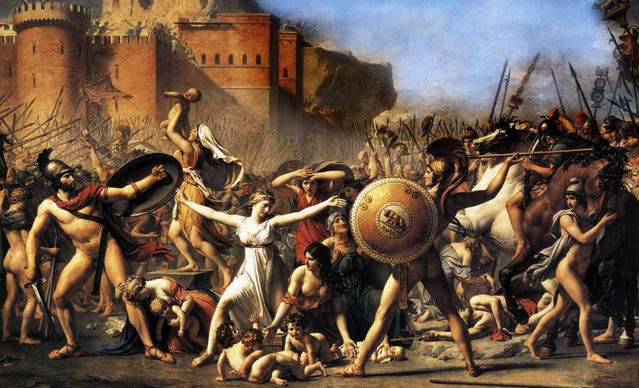Psychopathy
Are Heroes and Psychopaths Cut From the Same Cloth?
There is a complicated relationship between antisocial behavior and heroism.
Posted December 18, 2017
Psychopaths are usually thought of as malicious, selfish people who exploit and mistreat others without remorse. However, there has been debate about whether there might be a positive side to psychopathy, such as whether psychopathic traits contribute to socially valued behaviour such as acts of heroism. Some people have even argued that psychopaths and heroes may be “twigs off the same branch” who share a common core of fearlessness. A recent study suggests that people who perform heroic actions to help others at their own risk tend to be high in certain allegedly “psychopathic” traits. Much of this debate turns on how the concept of psychopathy is understood, and what its core features might be. There does seem to be a little understood overlap between antisocial behaviour and heroic tendencies. However, hard-core psychopaths are also highly unlikely to become heroes.
In a previous post, I discussed evidence that there is an overlap between antisocial behaviour and heroic behaviour, that is, behaviour aimed at helping another that involves danger to oneself. Additionally, I discussed a paper (Smith, Lilienfeld, Coffey, & Dabbs, 2013) arguing that psychopathic personality traits and heroism might have a common overlapping core. A new study on heroic behaviour (Patton, Smith, & Lilienfeld) extends the argument that psychopaths and heroes have “traits cut from the same cloth.” This study examined people who work in “first responder” professions, that is, those who deal with emergency situations involving risk to themselves, such as police, military personnel, emergency medical technicians, and firefighters, and compared them with people from the general community. First responders were chosen because the authors thought they might embody traits associated with hypothetical “successful psychopathy,” as they work in high-risk occupations and have many opportunities to perform heroic acts. This was based on the argument that one of the components of psychopathy is fearlessness, which enables a person to enter dangerous situations without being overcome by alarm. This in turn, might facilitate both heroic and antisocial behaviour involving danger. However, as I will discuss later, there is considerable debate about the importance and centrality of fearlessness in understanding psychopathy.

Participants in the study were assessed on a range of general and specific personality traits. The general personality traits, comprised the Big Five traits of extraversion, agreeableness, neuroticism, conscientiousness, and openness to experience. Additionally, they included three different measures of psychopathy and its various components, and a measure of antisocial personality disorder to assess history of antisocial behaviours. One model of psychopathy (the “triarchic” model) proposes that it consists of a combination of boldness (essentially fearlessness), meanness (callousness), and disinhibition (lack of self-control), and they included two different scales that measure versions of each of these components, although under different names (that is, one of the scales measures “fearless dominance,” “cold-heartedness,” and “self-centred impulsivity,” although these are basically identical to the traits in the triarchic model). Another model of psychopathy proposes that it has two factors of primary and secondary psychopathy, where the first represents the interpersonal and affective components, such as callous/manipulative tendencies (research has found this to be most strongly related to meanness), and the latter represents an erratic and antisocial lifestyle (this is related to a combination of meanness and disinhibition), and these were also measured. They also measured sensation-seeking (a trait related to risk-taking as well as boldness) and the “dark traits” of narcissism and Machiavellianism. The latter two, along with psychopathy, are said to make up the “dark triad” of aversive personality traits. To measure heroism, they included assessments of how many times a person had engaged in specific heroic behaviours (e.g., breaking up a physical fight, pulling over to assist a stranded motorist). Importantly, first responders were asked if these acts had occurred in the course of their duty or in their own time. This allowed an assessment of “off-duty” heroism. Additionally, they included measures of altruism that did not involve as much personal risk as the heroic behaviours, specifically altruistic behaviour towards strangers (such as helping someone push a car through mud/snow) and giving to charity. Participants were also asked about whether they had engaged in deviant workplace behaviours as a measure of antisocial behaviour.
Comparing the profiles of first responders with the community sample, seemed to suggest, at least on the surface, that there is a connection between psychopathic traits and heroic behaviour. Unsurprisingly, first responders reported greater off-duty heroism, stranger altruism, and charity giving than the community sample. More interestingly, they scored higher on all measures of psychopathy and its components, including the three components of boldness, meanness, and disinhibition, as well as primary and secondary psychopathy. They also scored higher on narcissism and Machiavellianism, sensation-seeking, and interpersonal workplace deviance (behaviours directly harmful to one’s colleagues). For general personality they scored higher on extraversion and lower on openness to experience. Therefore, as a group, first responders tend on average to both be more heroic and to display more psychopathic and dark traits than ordinary community members.
Although these results might seem to support the idea that greater psychopathy is linked with greater heroism, a closer look at how each of the personality measures are related to the behavioural measures shows that this is not entirely the case. When looking at the correlations for measures of boldness (fearlessness), meanness, and disinhibition with heroism, stranger altruism and charity, only boldness had positive correlations with the latter behaviours. On the other hand, measures of meanness and disinhibition had either negative or non-significant correlations with these behaviours. Additionally, primary psychopathy and Machiavellianism also had negative correlations with heroic and altruistic behaviours, although narcissism and antisocial personality disorder actually had modest positive correlations, while secondary psychopathy was unrelated to any of these behaviours. Interestingly, sensation-seeking was also positively correlated with heroic and altruistic behaviour. Note that these correlations apply to the full sample (both first responders and the community sample). Considering the community sample only, the results remained largely the same; considering the first responders only, the results were mostly similar, although boldness and sensation-seeking were no longer related to heroism, although they were still positively correlated with stranger altruism and charity. What these results suggest, is that among the supposedly psychopathic traits, only boldness/fearlessness was positively related to heroism (and only in the community sample), whereas the remaining traits of meanness and disinhibition, were negatively related to heroism (as well as altruistic behaviour more generally). That is, even though first responders generally were more likely to engage in off-duty heroism than civilians, and to be higher in all psychopathic traits, those first responders who were higher than average in the more socially aversive traits (i.e. psychopathic traits other than boldness), were less likely to engage in such behaviour compared to their colleagues with less aversive personalities. Furthermore, although first responders tend to be more fearless than other community members, as might be expected for people in dangerous occupations, within this group, boldness/fearlessness does not seem to be related to whether individuals perform heroic and altruistic behaviours outside of their work, although it is does predict such behaviour in civilians. Perhaps, this is because being high in boldness/fearlessness might be an occupational requirement for first responders, so there be something of a ceiling effect.
For general personality traits, off-duty heroism was positively correlated with openness to experience, extraversion, and to a lesser extent conscientiousness in the full sample. Interestingly, in the civilians only, off-duty heroism was associated with higher openness to experience, extraversion, and to a lesser extent agreeableness, and with lower neuroticism. In the first responders, off-duty heroism was associated with higher openness to experience and conscientiousness, and strangely enough with higher neuroticism but not with extraversion.
The results of this study therefore suggest that out of the psychopathic traits, only boldness/fearlessness is associated with greater heroism. On the other hand, meanness and disinhibition, which are more socially aversive than boldness, are associated with decreased heroism. However, there was a small positive association between antisocial personality disorder and heroism. These results agree with those of a previous study (Smith et al., 2013) that found that not only boldness but a history of antisocial behaviour were associated with greater heroism, while meanness and disinhibition were not. One implication of this is that prosocial behaviours that help others, such as heroism, and antisocial behaviours are not necessarily opposite ends of a spectrum, although the reasons for this are not well understood. In a previous post, I suggested that they might be linked by sensation-seeking, as this trait is not only associated with risk-taking but a positive view of dangerous situations and one’s ability to cope with them.
Whether one considers heroes and psychopaths to be cut from the same cloth depends on the importance of fearlessness to the concept of psychopathy. There is considerable evidence that the core of psychopathy is interpersonal antagonism, and that fearlessness might not be as essential to the concept of psychopathy in the way that meanness and disinhibition related traits are. This is a topic I will discuss in more detail in my next post.
© Scott McGreal. Please do not reproduce without permission. Brief excerpts may be quoted as long as a link to the original article is provided.
References
Patton, C. L., Smith, S. F., & Lilienfeld, S. O. (2017) Psychopathy and Heroism in First Responders: Traits Cut From the Same Cloth? Personality Disorders: Theory, Research, & Treatment. doi: 10.1037/per0000261
Smith, S. F., Lilienfeld, S. O., Coffey, K., & Dabbs, J. M. (2013). Are psychopaths and heroes twigs off the same branch? Evidence from college, community, and presidential samples. Journal of Research in Personality, 47(5), 634-646. doi:http://dx.doi.org/10.1016/j.jrp.2013.05.006


